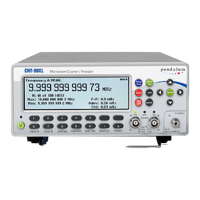vantage when you measure medium or long
time instabilities. Here averaging works as a
smoothing function, eliminating the effect of
jitter.
The signal in Fig. 6-1 contains a slower varia-
tion as well as jitter. When measuring jitter
you should use a limited number of samples,
so that the slow variation does not become
noticeable or alternatively use the dedicated
statistic measure for this kind of
measurement, the Allan deviation.
To measure the slower variation you calculate
Max, Min or Mean on a long series of aver-
aged samples. Here averaging eliminates the
jitter in each sample and the long measuring
time and large number of samples means that
the measurement can record very slow varia-
tions. The maximum pacing time is 500 s, the
maximum measuring time for each sample is
1000 s, and the maximum number of samples
is 2*10
9
, which in effect means that a single
data capture could theoretically span up to
3*10
12
s, or more than 95000 years.
Statistics and Mathematics
The counter allows you to perform mathemat-
ical operations on the measured value before
it is presented to the display or to the bus. See
Page 6-2 to get an overview of the four avail-
able equations.
Any systematic measurement uncertainty can
be measured for a particular measurement
setup, and the needed correction constants can
be entered into these equations. Statistics will
then be applied to the corrected measured
value.
The standard deviation can be used to calcu-
late the confidence limits of a measurement.
Where:
s
x = standard deviation
k = 1 for a confidence level of 68.3% (1
-
k = 2 for a confidence level of 95.5% (2
k = 3 for a confidence level of 99.7% (3
A measurement of a time interval of 100 s is
used to illustrate how the confidence limits
are calculated from the measurement result.
Use the statistics to determine the mean value
and standard deviation of the time interval.
Take sufficient samples to get a stable
reading. Assume further that the start and stop
trigger transitions are fast and do not
contribute to the measurement uncertainties.
MEAN value = 100.020 s and a STD DEV
= 50 ns, then the 95.5% confidence limits =
±2sx = ±2 * 50 ns = ±100 ns.
The 3
- limit will then be ±3 * 50 ns =
±150 ns
Statistics provides an easy method of deter-
mining the short term timing instability, (jit-
ter) of pulse parameters. The jitter is usually
specified with its rms value, which is equal to
the standard deviation based on single mea-
s
urements. The counter can then directly
me
asure and display the rms jitter.
Otherwise, the standard deviation of mean
values can be measured. The rms value is a
good measure to quantify the jitter, but it
gives no information about the distribution of
the measurement values.
USER MANUAL ● CNT 9x Series ● Rev.22 February 2020

